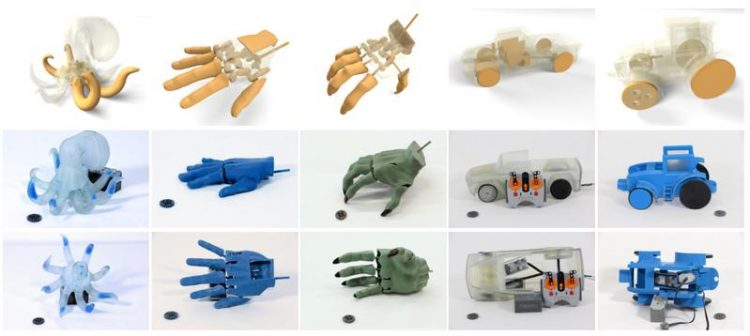Equipping form with function

Various results of the algorithm. The middle and bottom row show objects that have been fabricated by the researchers using 3D printing. IST Austria
Common toys such as steerable cars or waving wind-up figures are available as 3D-printable models, which also contain their mechanical components. However, these mechanical structures are optimized to fit exactly one particular shape of the toy.
If designers want to reuse such a mechanism with different shapes, the necessary manual adjustments to the individual components are often unmanageable for non-experts, in addition to being extremely tedious. Scientists at the Institute of Science and Technology Austria (IST Austria) in collaboration with colleagues from Adobe Research have now solved this problem by developing an interactive design tool that allows users to easily adjust a mechanical template to the shape of their choice.
The software tool, which will be made available in the future, will be presented at this year’s prestigious “SIGGRAPH” conference by first author and PhD student Ran Zhang from the research group of Bernd Bickel.
“Given a car model, there is usually one kind of mechanism that provides the functionality and, at the same time, thousands of different shapes that the car can have,” explains co-author Thomas Auzinger. “Our code bridges this gap and makes it possible to reuse the mechanism across all shapes. It allows for flexibility,” he adds.
People and computers have very different abilities and competences. While humans have an eye for the aesthetics, it is the computer that is best suited at enforcing mathematical constraints and at optimizing the functionality of the generally large number of connected mechanical components, such as axles, gears, wheels, etc. This is why the user and the code interactively work together in an approach that the researchers took for the first time. “Our tool always guarantees functionality, while artists can adjust the mechanical template to fit the design of their choice,” explains lead author Ran Zhang.
Three Austrian artists have tested the program already. The professional 3D-modellers came to visit IST Austria in Klosterneuburg, imported the mechanical template of their choice and adjusted it to fit self-designed 3D-shapes without having to worry about mechanical constraints. Normally, extensive manual adjustments to each of the individual components of the mechanical structure would have been necessary — a task that is tedious if not downright impossible for non-experts. With the newly developed tool, in contrast, adjustment is easy and happens in real time. “Even novice users will be able to create a functional model from the shape of their choice,” says Ran Zhang.
The viability of the novel tool was shown for different mechanical templates: for waving wind-up toys, periodic motions of hand models, steerable and motorized RC cars, and for vehicles with moveable rotors such as helicopters and planes. Each of them can be adjusted to produce a wide variety of differently-shaped figurines and vehicles. “While our result is already quite applicable, I want to point out that it is still an explorative research project,” says Thomas Auzinger. “We took an entirely new modeling approach based on mathematical optimization and showed its viability. It was a proof of concept.”
Professor Bernd Bickel, who previously worked at Disney Research in Zürich and at the Technical University of Berlin, joined IST Austria in 2015. He leads a research group on computer graphics and digital fabrication. Ran Zhang, first author of the study, graduated from the University of Science and Technology of China and is a PhD student in his group. Co-author Thomas Auzinger, who obtained his PhD from the TU Wien, is a postdoc at IST Austria. Co-author Duygu Ceylan who obtained her PhD from EPFL, Switzerland is now a research scientist at Adobe Research. Co-author Wilmot Li, who obtained his PhD from the University of Washington is a principal scientist at Adobe Research.
Find out more about the project here
http://visualcomputing.ist.ac.at/publications/2017/MechRet/
Demo video_Functionality-aware Retargeting of Mechanisms to 3D Shapes
Media Contact
All latest news from the category: Information Technology
Here you can find a summary of innovations in the fields of information and data processing and up-to-date developments on IT equipment and hardware.
This area covers topics such as IT services, IT architectures, IT management and telecommunications.
Newest articles

NASA: Mystery of life’s handedness deepens
The mystery of why life uses molecules with specific orientations has deepened with a NASA-funded discovery that RNA — a key molecule thought to have potentially held the instructions for…

What are the effects of historic lithium mining on water quality?
Study reveals low levels of common contaminants but high levels of other elements in waters associated with an abandoned lithium mine. Lithium ore and mining waste from a historic lithium…

Quantum-inspired design boosts efficiency of heat-to-electricity conversion
Rice engineers take unconventional route to improving thermophotovoltaic systems. Researchers at Rice University have found a new way to improve a key element of thermophotovoltaic (TPV) systems, which convert heat…



